by Calculated Risk on 3/15/2021 09:12:00 PM
Monday, March 15, 2021
Tuesday: Retail Sales, Industrial Production, Homebuilder Survey
From Matthew Graham at Mortgage News Daily: MBS RECAP: Fighting Good Fight, Waiting on Fed Day
Coming off a fairly rough Friday at the end of last week, it's mildly reassuring to begin the new week with no additional damage. ... The takeaway is simple: it's a rising rate environment until proven otherwise. If one event has the power to change the trading tone in bonds this week, it's Wednesday's Fed Announcement [30 year fixed 3.33%]Tuesday:
emphasis added
• At 8:30 AM ET, Retail sales for February is scheduled to be released. The consensus is for a 0.5% decrease in retail sales.
• At 9:15 AM, The Fed will release Industrial Production and Capacity Utilization for February. The consensus is for a 0.6% increase in Industrial Production, and for Capacity Utilization to increase to 75.8%.
• At 10:00 AM, The March NAHB homebuilder survey. The consensus is for a reading of 83, down from 84. Any number above 50 indicates that more builders view sales conditions as good than poor.
March 15 COVID-19 Test Results and Vaccinations
by Calculated Risk on 3/15/2021 06:52:00 PM
From Bloomberg on vaccinations as of Mar 15th:
"So far, 109 million doses have been given. In the last week, an average of 2.43 million doses per day were administered."Here is the CDC COVID Data Tracker. This site has data on vaccinations, cases and more.
And check out COVID Act Now to see how each state is doing. (updated link to new site)
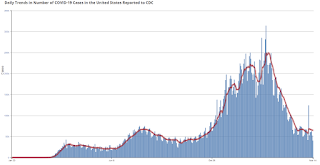 Click on graph for larger image.
Click on graph for larger image.This graph shows the daily (columns) 7 day average (line) of positive tests reported.
This data is from the CDC.
Note that last week, Missouri reported 81,000 previously unreported cases, and that caused the spike in total cases (and an increase in 7 day average).
MBA Survey: "Share of Mortgage Loans in Forbearance Decreases to 5.14%"
by Calculated Risk on 3/15/2021 04:00:00 PM
Note: This is as of March 7th.
From the MBA: Share of Mortgage Loans in Forbearance Decreases to 5.14%
The Mortgage Bankers Association’s (MBA) latest Forbearance and Call Volume Survey revealed that the total number of loans now in forbearance decreased by 6 basis points from 5.20% of servicers’ portfolio volume in the prior week to 5.14% as of March 7, 2021. According to MBA’s estimate, 2.6 million homeowners are in forbearance plans.
...
“One year after the onset of the pandemic, many homeowners are approaching 12 months in their forbearance plan. That is likely why call volume to servicers picked up in the prior week to the highest level since last April, and forbearance exits increased to their highest level since January. With new forbearance requests unchanged, the share of loans in forbearance decreased again,” said Mike Fratantoni, MBA’s Senior Vice President and Chief Economist. “Homeowners with federally backed loans have access to up to 18 months of forbearance, but they need to contact their servicer to receive this additional relief.”
Fratantoni added, “The American Rescue Plan provides needed support for homeowners who are continuing to struggle during these challenging times, and stimulus payments are being delivered to households now. We anticipate that this support, along with the improving job market, will help many homeowners to get back on their feet.”
emphasis added
 Click on graph for larger image.
Click on graph for larger image.This graph shows the percent of portfolio in forbearance by investor type over time. Most of the increase was in late March and early April, then trended down - and has mostly moved slowly down recently.
The MBA notes: "Total weekly forbearance requests as a percent of servicing portfolio volume (#) remained the same relative to the prior two weeks at 0.07%."
Boston Real Estate in February: Sales Up 7% YoY, Inventory Down 13% YoY
by Calculated Risk on 3/15/2021 03:09:00 PM
Note: I'm posting data for many local markets around the U.S. The story is the same just about everywhere ... inventory is at record lows.
For Boston (single family and condos):
Closed sales in February 2021 were 1,233, up 6.7% from 1,156 in February 2020.
Active Listings in February 2021 were 2,968, down 12.7% from 3,398 in February 2020.
Second Home Market: South Lake Tahoe
by Calculated Risk on 3/15/2021 12:05:00 PM
Last week, from Jann Swanson at MortgageNewsDaily: Fannie Warns Lenders on Investment Properties and 2nd Homes. This action will result in higher interest rates on 2nd home and investment property mortgages.
I'm looking at data for some second home markets - and will track those markets to see if there is an impact from the lending changes.
This graph is for South Lake Tahoe since 2004 through February 2021, and shows inventory (blue), and the year-over-year change in the median price (12 month average).
Note: The median price is distorted by the mix, but this is the available data.
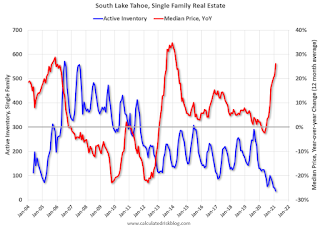
Following the housing bubble, prices declined for several years in South Lake Tahoe, with the median price falling about 50% from the bubble peak.
Note that inventory was high while prices were declining - and significantly lower inventory in 2012 suggested the bust was over. (Tracking inventory helped me call the bottom for housing way back in February 2012, see:The Housing Bottom is Here)
Currently inventory is at a record low, and prices are up sharply. This will be interesting to watch.
Housing Inventory March 15th Update: At Record Lows
by Calculated Risk on 3/15/2021 10:51:00 AM
One of the key questions for 2021 is: Will inventory increase as the pandemic subsides, or will inventory decrease further in 2021?
Tracking inventory will be very important this year.

This inventory graph is courtesy of Altos Research.
Mike Simonsen discusses this data regularly on Youtube.
BLS: January Unemployment rates down in 33 States
by Calculated Risk on 3/15/2021 10:08:00 AM
From the BLS: Regional and State Employment and Unemployment Summary
Unemployment rates were lower in January in 33 states and the District of Columbia and stable in 17 states, the U.S. Bureau of Labor Statistics reported today. Forty-eight states and the District had jobless rate increases from a year earlier and two states had little change. The national unemployment rate, 6.3 percent, fell by 0.4 percentage point over the month, but was 2.8 points higher than in January 2020.Hawaii is being impacted by the lack of tourism.
Nonfarm payroll employment increased in 20 states, decreased in 2 states, and was essentially unchanged in 28 states and the District of Columbia in January 2021. Over the year, nonfarm payroll employment decreased in 48 states and the District and was essentially unchanged in 2 states.
...
Hawaii and California had the highest unemployment rates in January, 10.2 percent and 9.0 percent, respectively, while South Dakota and Utah had the lowest rates, 3.1 percent each.
Seven High Frequency Indicators for the Economy
by Calculated Risk on 3/15/2021 08:31:00 AM
These indicators are mostly for travel and entertainment. It will interesting to watch these sectors recover as the vaccine is distributed.
The TSA is providing daily travel numbers.
 Click on graph for larger image.
Click on graph for larger image.This data shows the seven day average of daily total traveler throughput from the TSA for 2019 (Light Blue), 2020 (Blue) and 2021 (Red).
The dashed line is the percent of 2019 for the seven day average.
This data is as of March 14th.
The seven day average is down 51.1% from the same week in 2019 (48.9% of last year). (Dashed line)
There was a slow increase from the bottom, with ups and downs due to the holidays - and TSA data has moved up in 2021.
The second graph shows the 7 day average of the year-over-year change in diners as tabulated by OpenTable for the US and several selected cities.
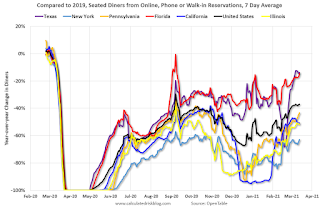 Thanks to OpenTable for providing this restaurant data:
Thanks to OpenTable for providing this restaurant data:This data is updated through March 13, 2021.
This data is "a sample of restaurants on the OpenTable network across all channels: online reservations, phone reservations, and walk-ins. For year-over-year comparisons by day, we compare to the same day of the week from the same week in the previous year."
Note that this data is for "only the restaurants that have chosen to reopen in a given market". Since some restaurants have not reopened, the actual year-over-year decline is worse than shown.
Dining picked up during the holidays, then slumped with the huge winter surge in cases. Dining is picking up again.
 This data shows domestic box office for each week and the median for the years 2016 through 2019 (dashed light blue).
This data shows domestic box office for each week and the median for the years 2016 through 2019 (dashed light blue). Note that the data is usually noisy week-to-week and depends on when blockbusters are released.
Movie ticket sales were at $21 million last week, down about 89% from the median for the week.
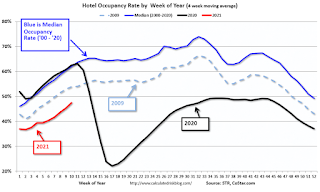 This graph shows the seasonal pattern for the hotel occupancy rate using the four week average.
This graph shows the seasonal pattern for the hotel occupancy rate using the four week average. The red line is for 2021, black is 2020, blue is the median, and dashed light blue is for 2009 (the worst year since the Great Depression for hotels - before 2020).
Even when occupancy increases to 2009 levels, hotels will still be hurting.
This data is through March 6th. Hotel occupancy is currently down 20.5% year-over-year (down 26.7% compared to same week in 2019). Starting next week, the year-over-year comparisons will be easy - since occupancy declined sharply at the onset of the pandemic - but occupancy will still be down significantly from normal levels.
Notes: Y-axis doesn't start at zero to better show the seasonal change.
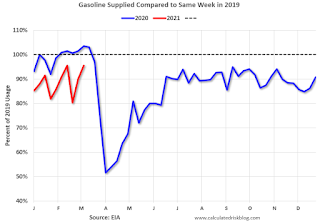 This graph, based on weekly data from the U.S. Energy Information Administration (EIA), shows gasoline supplied compared to the same week of 2019.
This graph, based on weekly data from the U.S. Energy Information Administration (EIA), shows gasoline supplied compared to the same week of 2019.Blue is for 2020. Red is for 2021.
As of March 5th, gasoline supplied was off about 4.5% (about 95.5% of the same week in 2019).
Gasoline supplied will be up year-over-year soon, since at one point, gasoline supplied was off almost 50% YoY in 2020.
This graph is from Apple mobility. From Apple: "This data is generated by counting the number of requests made to Apple Maps for directions in select countries/regions, sub-regions, and cities." This is just a general guide - people that regularly commute probably don't ask for directions.
There is also some great data on mobility from the Dallas Fed Mobility and Engagement Index. However the index is set "relative to its weekday-specific average over January–February", and is not seasonally adjusted, so we can't tell if an increase in mobility is due to recovery or just the normal increase in the Spring and Summer.
 This data is through March 11th for the United States and several selected cities.
This data is through March 11th for the United States and several selected cities.The graph is the running 7 day average to remove the impact of weekends.
IMPORTANT: All data is relative to January 13, 2020. This data is NOT Seasonally Adjusted. People walk and drive more when the weather is nice, so I'm just using the transit data.
According to the Apple data directions requests, public transit in the 7 day average for the US is at 56% of the January 2020 level. It is at 50% in Chicago, and 59% in Houston (the dip was a weather related decline) - and moving up recently.
Here is some interesting data on New York subway usage (HT BR).
 This graph is from Todd W Schneider. This is weekly data since 2015.
This graph is from Todd W Schneider. This is weekly data since 2015. This data is through Friday, March 12th.
Schneider has graphs for each borough, and links to all the data sources.
He notes: "Data updates weekly from the MTA’s public turnstile data, usually on Saturday mornings".
Sunday, March 14, 2021
Sunday Night Futures
by Calculated Risk on 3/14/2021 08:07:00 PM
Weekend:
• Schedule for Week of March 14, 2021
• FOMC Preview
Monday:
• 8:30 AM ET, The New York Fed Empire State manufacturing survey for March. The consensus is for a reading of 14.5, up from 12.1.
• 10:00 AM, State Employment and Unemployment (Monthly) for January 2021
From CNBC: Pre-Market Data and Bloomberg futures S&P 500 futures are up 4 and DOW futures are up 75 (fair value).
Oil prices were down over the last week with WTI futures at $65.91 per barrel and Brent at $69.48 per barrel. A year ago, WTI was at $29, and Brent was at $28 - so WTI oil prices are UP more than double year-over-year (oil prices collapsed at the beginning of the pandemic).
Here is a graph from Gasbuddy.com for nationwide gasoline prices. Nationally prices are at $2.86 per gallon. A year ago prices were at $2.21 per gallon, so gasoline prices are up $0.65 per gallon year-over-year.
March 14 COVID-19 Test Results and Vaccinations
by Calculated Risk on 3/14/2021 06:55:00 PM
From Bloomberg on vaccinations as of Mar 13th:
"So far, 107 million doses have been given. In the last week, an average of 2.39 million doses per day were administered."Here is the CDC COVID Data Tracker. This site has data on vaccinations, cases and more.
And check out COVID Act Now to see how each state is doing. (updated link to new site)
 Click on graph for larger image.
Click on graph for larger image.This graph shows the daily (columns) 7 day average (line) of positive tests reported.
This data is from the CDC.
Note that last week, Missouri reported 81,000 previously unreported cases, and that caused the spike in total cases (and an increase in 7 day average).
The second graph shows the number of people hospitalized.
 This data is also from the CDC.
This data is also from the CDC.The CDC cautions that due to reporting delays, the area in grey will probably increase.


